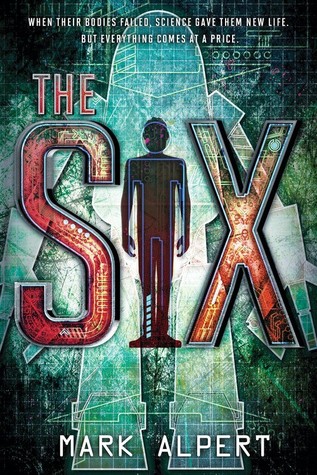
This book was one of the featured titles at BEA last month, and we’re so excited to reveal the awesome Book Trailer for The Six by Mark Alpert today:
***About the Book***
 The Six by Mark Alpert
The Six by Mark Alpert Published by Sourcebooks Fire on July 7, 2015
Genres: Sci-Fi
Pages: 368
Goodreads Buy the Book
To save humanity, they must give up their own.
Adam's muscular dystrophy has stolen his mobility, his friends, and in a few short years, it will take his life. Virtual reality games are Adam's only escape from his wheelchair. In his alternate world, he can defeat anyone. Running, jumping, scoring touchdowns: Adam is always the hero.
Then an artificial intelligence program, Sigma, hacks into Adam's game. Created by Adam's computer-genius father, Sigma has gone rogue, threatening Adam's life-and world domination. Their one chance to stop Sigma is using technology Adam's dad developed to digitally preserve the mind of his dying son.
Along with a select group of other terminally ill teens, Adam becomes one of the Six who have forfeited their bodies to inhabit weaponized robots. But with time running short, the Six must learn to manipulate their new mechanical forms and work together to train for epic combat...before Sigma destroys humanity.
***EXCERPT***
Shannon rears back in her seat as if she’s been slapped. “And where are you going to store the copies of our brains?” Her voice is furious. “In a supercomputer? A big electronic prison?”
Dad doesn’t take offense. He answers her calmly. “The scanning process converts human intelligence to a digital form, allowing it to run on any neuromorphic computer that has enough memory and processing power. But in the initial stage right after the transfer, we believe it’s important to connect the intelligence to a machine that can move around and sense the outside world. A human intelligence is accustomed to controlling a body, so if we want to preserve its sanity, we’d better give it something to control. Here, let me show you.”
He puts the vial of nanoprobes back in his pocket and pulls out something else, a small remote–control device. He points it at the doorway beside the stage, and a moment later I hear a loud clanking. The noise startles the soldiers standing by the doorway. They step backward, flattening themselves against the wall. Then a seven–foot–tall robot emerges from the doorway and brushes past them.
The robot strides across the stage. It has two arms and two legs, but otherwise it isn’t very humanlike. It has no head or neck. Its torso is shaped like a giant bullet, with the rounded end on top. Its legs angle downward from the base of its torso and rest on oval steel–plate footpads that clang against the floor.
The machine marches briskly past the podium and stops in front of my dad, who presses a button on his remote control. This command extends the robot’s arms, which telescope to a full length of six feet. They look like multi–jointed tentacles. The machine’s hands, though, resemble human hands, with dexterous mechanical fingers and thumbs.
Dad presses another button, and the robot’s rounded top starts to turn like a turret. “The cameras and acoustic sensors are up here,” Dad says, pointing at the top end. “But the neuromorphic electronics are deep inside the torso, encased in armor plating. These robots were originally designed for the war in Afghanistan, so they’re pretty sturdy.” He raps his knuckles against the torso. “All in all, it’s an excellent platform for a newly transferred intelligence, but really it’s just the beginning. The whole point of the Pioneer Project is to bridge the gap between man and machine, and that means the human intelligences must explore their new environment. The Pioneers will have to learn how to use their new capabilities, and that includes transferring their intelligences from one machine to another.”
His voice grows louder again, full of enthusiasm. “Once the Pioneers have mastered these tasks, our hope is that they’ll be able to establish a connection with Sigma. If all goes well, they’ll start communicating with the AI before it launches any of the Russian missiles. And then the toughest challenge will begin. At the same time that the humans are learning how to be machines, they’ll have to teach Sigma how to be human.”
***About Mark Alpert***
 Mark Alpert is a former editor at Scientific American, and the author of several adult thrillers. He’s been praised by Douglas Preston as the “heir to Michael Crichton.”
Mark Alpert is a former editor at Scientific American, and the author of several adult thrillers. He’s been praised by Douglas Preston as the “heir to Michael Crichton.”
***GIVEAWAY***
Let us know what you think! Are you as excited about this book as we are?









































































